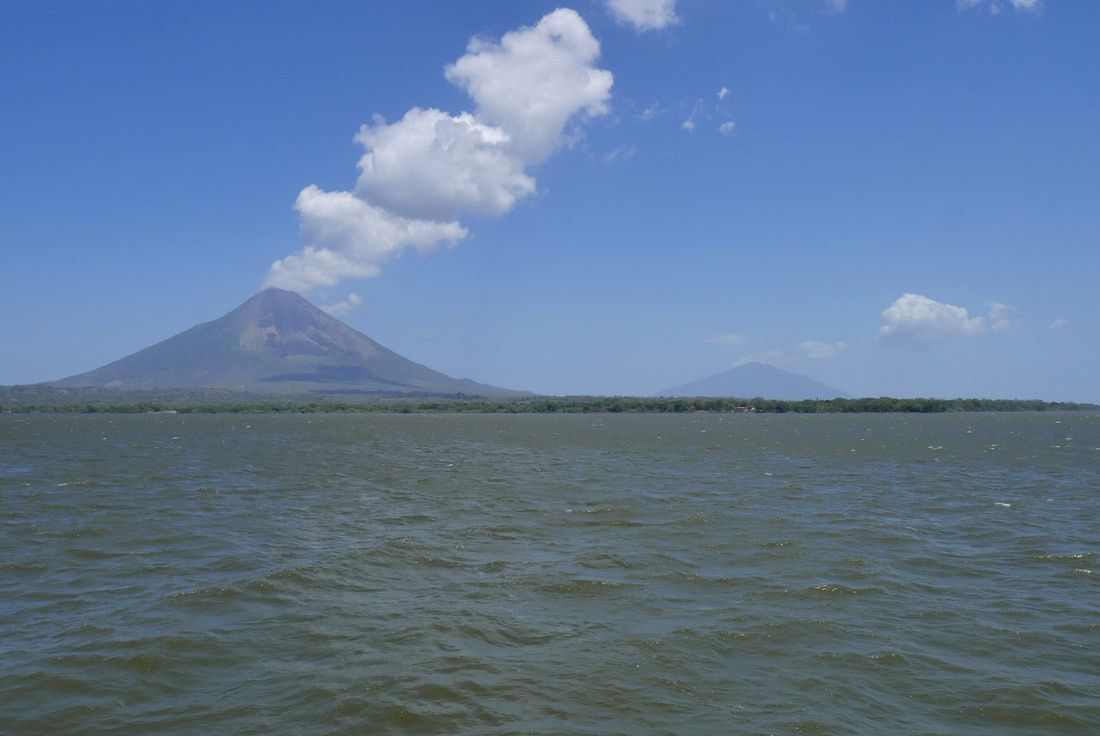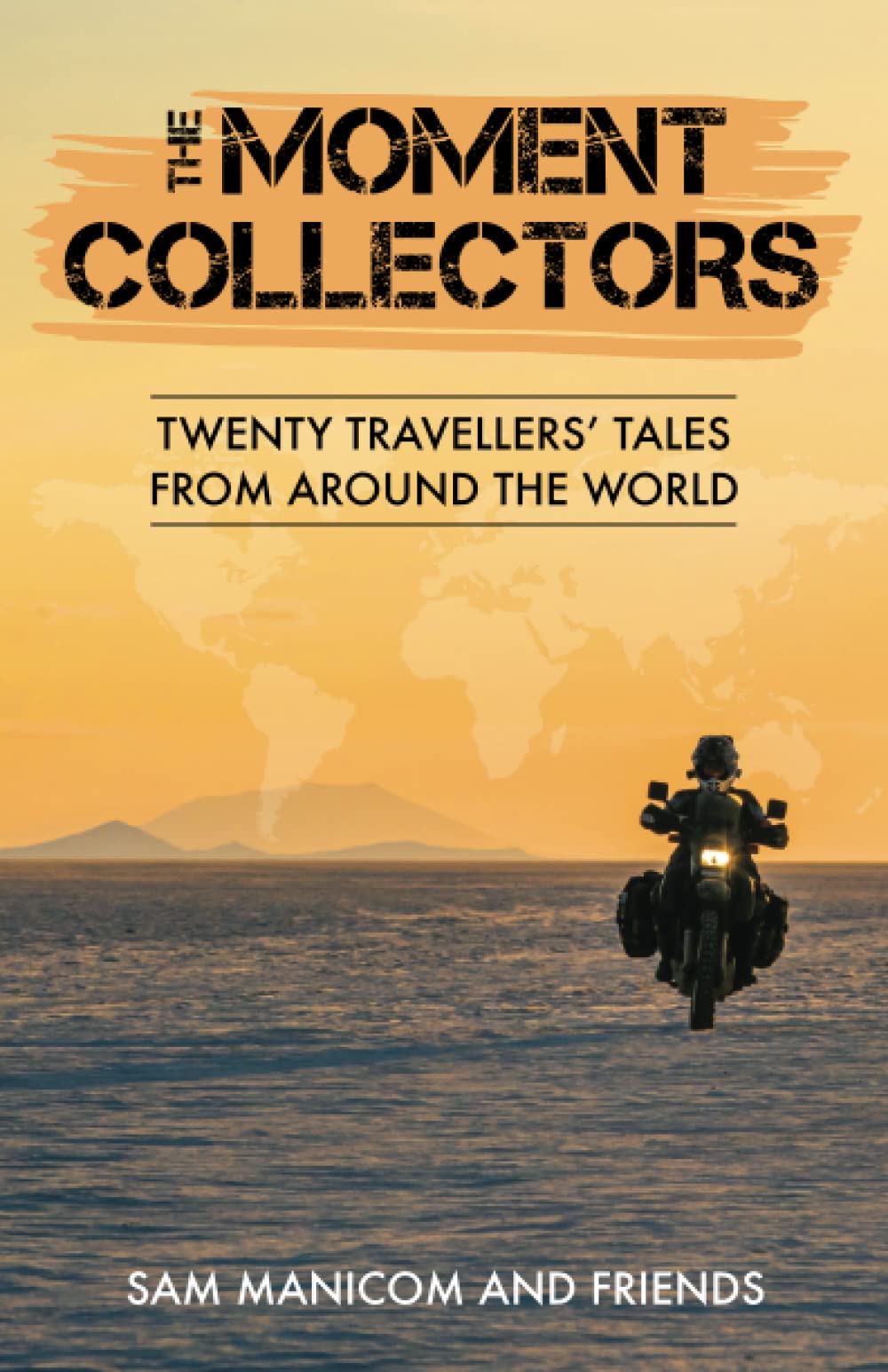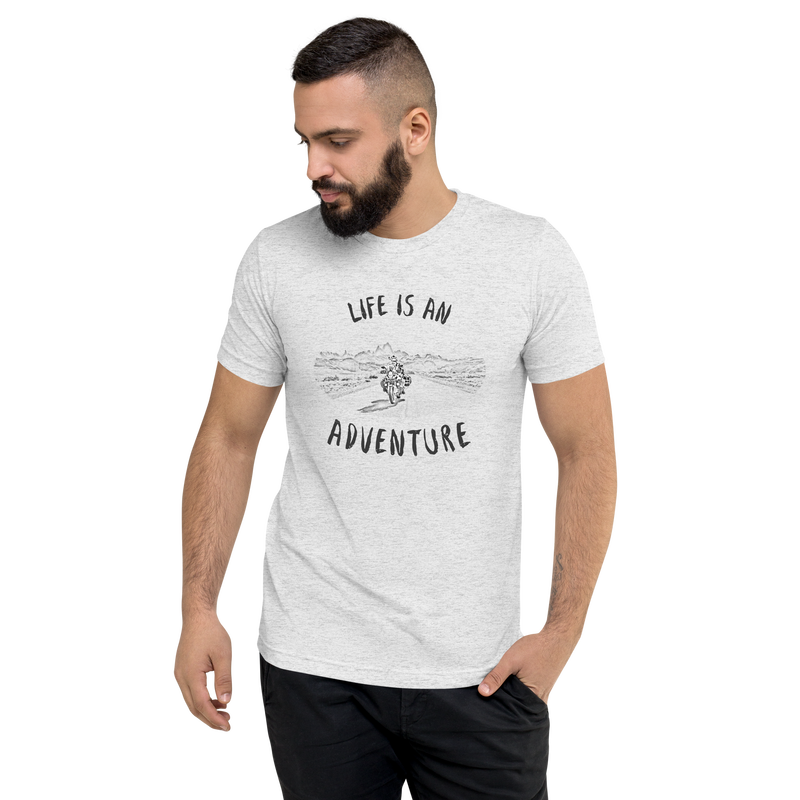By Marisa
About ten years ago, I had a friend who said he visited Nicaragua while studying abroad at a university in Costa Rica. He only crossed the border into Nicaragua for a day or two, but when he told me this, I thought he must have either been the bravest, or stupidest, person in the world. Visions of communist jungle guerrillas trafficking cocaine flashed through my mind: men wearing green uniforms and fully equipped with both Kalashnikovs and machetes. I wondered why my friend would go to such a place and I remember thinking, “Good for you, but I wouldn’t go there.” Of course, if I could go back in time and tell myself that not even a decade later I would be traversing this country by motorcycle for over a month, I probably wouldn’t have believed it. And Nicaragua turned out to be nothing like my imagined doomsday exaggerations. It is actually an incredible place full of friendly people, breathtaking views, and the most dangerous thing we encountered while there were its fire-breathing volcanoes. Unlike what I used to think, Nicaragua has statistically become one of the safest Central American countries, and its popularity as a tourist destination has skyrocketed in recent years. That being said, soon after we left in March 2018, a string of violent riots over a new social security referendum may have changed the country’s overall safety record. The government has now repealed this unpopular referendum, and things have supposedly returned to normal, but even so, if you plan to visit, it’s a good idea to keep up to date with your news. If you look at the map of Nicaragua, you’ll notice that it’s somewhat shaped like a triangle, and the whole north-eastern section of it is forest and mostly road-less, which is why we skipped that area. Though we heard the Caribbean coast was nice, getting there and back from the Pacific side would have been a challenge, not to mention time consuming (it doesn’t look far on the map, but poor road conditions make the journey long). So we stuck to the south-western half which is impressive by itself, dotted with volcanoes, craters, and lakes. We did not experience any of Nicaragua’s famous beaches since we knew we’d be getting plenty of beach time farther along our journey south, so we decided to visit Nicaragua’s distinctive cities, volcanoes, and lakes instead. These days, many travelers are touting Nicaragua as “the new Costa Rica.” My personal opinion after having visited both countries is that Nicaragua is really unlike Costa Rica, and one should not go to Nicaragua thinking it’s simply the cheaper version of Costa Rica (which I originally had thought). First of all, they are climatically very different, which makes the wildlife and vegetation of Costa Rica more rainforest-like, whereas Nicaragua has a larger variety of volcanoes and lakes to explore. Also, because of Nicaragua’s recent popularity, Tim and I did not find it to be that much cheaper than Costa Rica (nor did we find Costa Rica to be as expensive as everyone said). But when people call it “the new Costa Rica,” if they mean that Nicaragua is the new tourist hot-spot of Central America, then that could very well be true. While in Nicaragua, Tim and I visited archeological sites (Viejo León), boarded down a volcano (Cerro Negro), and hung out on the lakeside beaches of Ometepe Island. Overall, we had an incredible time with almost no bad experiences (heat and mosquitoes excluded). So if you want to visit Nicaragua, which you definitely should, then here are my top three suggestions on what to do based on our own travels: My Top 3 Suggestions of What to Do in Nicaragua:3) Visit the Colonial Cities of Granada and LeonThough we only passed through the colorful and quaint town of Granada, we stayed a week in Leon, and can say that if you like historic churches, inviting plazas, brightly painted buildings with terracotta-tiled rooftops, and a laid-back attitude where everyone takes siestas, then these old Spanish colonial towns perfectly fit the bill. Leon and Granada are not near each other, so if you are visiting Nicaragua and need to pick one of the two, I would say Granada is the more famous of the two and is cleaner, well-restored, and has nicer hotels and restaurants. It even has a whole fleet of horse-drawn carriages to take you around town instead of taxis. Plus, it’s near to the views and fresh breezes of Lake Cocibulca (a.k.a. Lake Nicaragua, where Ometepe Island is). Unfortunately, all these wonderful things mean Granada is expensive. And touristy. Leon, on the other hand, is cheaper, less touristy, and is a backpacker favorite since it’s the jumping-off point to lots of Nicaragua’s famous volcanoes and hikes. Leon boasts plenty of hostels, a pumping night scene, and gorgeous churches. It’s dirtier than Granada (don’t even look at its river, there’s so much trash in it you’ll want to cry), and it’s insanely hot there. It was the hottest place we stayed in Nicaragua, and that says a lot. But if you want to volcano board or check out other amazing volcano hikes, then you’ll probably be stopping by Leon. During our stay in Leon, it was so full of mosquitoes, that we actually had to set up our tent inside our room to sleep in. And it was sweltering inside that tent, so we placed a fan to face inside, and it was still hot. True, it was the height of the dry season and the hottest part of the year (March), but it was almost unbearable for us. But don’t worry, if you visit, you don’t have to suffer like we did. Simply find a place with AC and you’ll be just fine. 2) Volcanoes!Nicaragua has an astounding 28 volcanoes, 19 of which are active! Some of the world’s most picturesque and impressive volcanoes are in Nicaragua, such as Momotombo (1,258m/4,127ft) on the shores of Lago Xolotlán (a.k.a. Lake Managua), San Cristóbal (1,745m/5,725ft) near the town of Chinandega, and Concepción Volcano (1,610m/5,282ft) which makes up the western side of Ometepe Island. We stood at the foot of all three of these massive smoking megaliths and can say that they are each stunning, heart-pounding, and truly memorable sights to behold. The only volcano that we climbed to the top of was called Cerro Negro (and you guessed it, it’s black in color because of all the volcanic ash). Cerro Negro is active, and you could see and feel it smoking beneath your feet at the top which was a very eerie experience. It is not the most picturesque of Nicaragua’s volcanoes from the ground, but the reason why people scale it is because you can actually ride a wooden board down one side of it, a one-of-a-kind activity called volcano boarding (check out our video Nicaragua Part I to see us in action). It was about an hour hike up and then just a minute boarding down, but it was so much fun, and is certainly the only place in the world where you can do such a bizarre thing. One word of warning if you ever find yourself volcano boarding: keep your speed under control in the beginning or you may quickly get out of control like Tim did. He even flew off at the end, but was mostly unharmed (only had a sore right leg for a few days). In order to go volcano boarding, you must join a tour group, and we joined Quetzaltrekkers which we would highly recommend. Not only are they wonderful and fun people, and you receive a t-shirt at the end, but they give a portion of your money to local children’s education. Unlike Cerro Negro, Momotombo, and San Cristóbal, Nicaragua also features many dormant volcanoes and ancient volcano-made craters. We hiked up one of these near Managua called Apoyeque, and even though the hike was so hot I just about thought I was going to die, once reaching the edge of the crater, we were greeted with pristine views and refreshing breezes from this crystal lake inside what had once been a massive bowl-like volcano. There was nobody else there, and no houses or any other structures in sight. Even though we were a short day trip from Nicaragua’s capital city, I felt like I could have stepped through a portal in time and might have been standing somewhere in the Jurassic period with Pterodactyls flying overhead. But of all the volcanoes we visited in Nicaragua, I have to say that one of the most unique was Masaya. Not even a half-hour drive from the commercial bustle of Managua, Masaya is a highly-active smoking crater that you can stand on the edge of, look down into, listen to the deep rumbling of the volcano, and you can do this all without any sort of hiking. That’s right, there is a parking lot at the edge of this volcano that you drive right up to! This means that the volcano edge is wheel-chair accessible, which delighted me to think that all types of people can experience this natural wonder which is usually only considered to be accessible to the most fit of hikers. So if you’ve never set foot on a volcano and you want to, Nicaragua is definitely the place to go for all your volcano adventures. 1) Ometepe IslandFor Tim and I, this hourglass-shaped island in a lake was the biggest draw in Nicaragua for us. We had heard about it back in Guatemala, and had been thirsting to see it ever since. Picture this: a tropical island in a giant freshwater lake, the island is made up of two perfectly conical volcanoes and there is a little road that goes all the way around it in a figure eight. Plus, it’s an island that you can easily ferry your motorcycle across to! We were excited, and the place did not disappoint. Pictures just don’t do it justice, because once you’re there, you’ll realize what a perfect piece of paradise the island of Ometepe is. There are white-face monkeys that swing from the trees, black sand beaches lined with colorful hammocks, heavenly fresh-water swimming holes such as Ojo de Agua, and there are even wild horses roaming the island and beaches! And because it’s an island in a lake and not the ocean, the horses just live out on the beaches eating the grass and drinking the water, they swim and then find shade in the palm trees to escape the heat of the day, much like the people of Ometepe. Pure divinity! I will say, Ometepe is hot, really hot. So if you’re one of the many people who want to climb one or both of the volcanoes while there, just remember that it’s going to be a sweltering trek. But if you’re the type of person who just wants to relax by the water like we did (Ojo de Agua or Santo Domingo Beach), you will definitely be in the right place for that. The worst part of Ometepe for us was the ferry over. Not that there was anything wrong with it: it was reasonably priced, and it left on time (more or less). But it’s just that whenever we put our bike on a floating craft of some sort, it’s always a bit nerve-wracking. And it was hot on the ferry and people were fighting for seats, but it was all worth it because the destination was so great. There are a couple of little towns on Ometepe Island with lots of places to eat, drink, and stay. We opted to camp on a lakeside farmstead that was walking distance to a local’s organic restaurant. Restaurants and amenities are expensive on the island, but that’s expected since if it’s not bananas, then it’s probably being shipped there. So if you want volcanoes, beaches, tropical wildlife, and a taste of the local Nicaraguan culture all in one place, Ometepe has it all and should not be missed! A few things I found interesting or surprising about Nicaragua:Horses are Everywhere! Even in the middle of Managua, the capital city of Nicaragua, horses were pulling carts and wagons. Horses are still used in Nicaragua for daily life by many people, such as cowboys herding their cattle, or merchants selling their fruits and vegetables from a horse cart. They are even used for transporting people and tourists around town. But most surprising to me was that there seemed to be wild horses all around Nicaragua as well. Not just Ometepe Island had wild horses, there were herds just roaming the sides of country roads all over the place. It’s dry: For some reason, I thought Nicaragua was going to be a humid rainy jungle, and it really wasn’t at all. Well, it does supposedly get much wetter in the rainy season (we came in the dry season), but besides the monkeys in the trees of Ometepe Island, we did not really encounter anything that would remotely be called rainforest. Nicaragua was mostly farmland, dry fields with scraggily trees adding a bit of green. Nicaragua is considered to be a dry tropical climate, not desert, but not rainforest either, and it more resembled its northern neighbors of Honduras and El Salvador than its rainy southern neighbors of Costa Rica and Panama. No tortillas: I don’t know what I was expecting with Nicaraguan food, but since I really had no idea what it could be, I just figured it would be like Mexican food. Of course it wasn’t, though many of the same ingredients of corn, tomatoes, rice, and beans were used, they were prepared in different ways. Unlike Mexico or Guatemala, tortillas and refried beans were not normally served in Nicaragua. The typical Nicaraguan food that you find on the street consists of grilled and stewed meats alongside a rice and bean mixture called Gallo Pinto (colored rooster is what it’s called, which is strange since there’s definitely no chicken in it, though the black beans do give it a lovely purple color). Every meal nearly always comes with fried plantains (called maduros) and instead of tortilla chips, you often find plantain chips, which I just adored. And finally, if you are thinking of one day visiting the country... A few of my tips of what to expect in Nicaragua:As far as cleanliness, litter, and road conditions go, I felt Nicaragua was somewhere in between the pervasive trash of Honduras, and the pristine highways of Costa Rica. It is definitely poor, and you are reminded of this fact on a daily basis by the burning garbage and developing infrastructure. But the people of Nicaragua are so friendly and happy, that sometimes it’s easy to forget the hardships they have had to face. Nicaragua is hot (have I mentioned that yet?), and you can say goodbye to taking hot showers (but you won’t want them anyway). Most of the time our showers consisted of a water spout coming out of the wall, but that was fine with us, and we found ourselves sometimes taking showers three or four times a day just so our brains didn’t boil in our heads. And lastly, in order to fully enjoy Nicaragua, you have to be alright with a bit of grime, crazy drivers, and unexpected road conditions. You have to come to the understanding that things will take a long time, nothing will run on a schedule, and plans may have to change. But if you can do that, you will have a great time in Nicaragua, (and this could probably be said for the whole of Central America). Overall, Nicaragua was unexpected in its austere beauty and the incredible hospitality of the people there (I’m looking at you Yesenia and Raul!). With all its smoking volcanoes, the country is full of opportunities for adventure, and with its massive lakes and long coastlines, there are also plenty of places to relax by the water. Laid-back, and coming into its own, Nicaragua is long over its old reputation, and it has now turned a new page to rightfully become the latest rage in Central American destinations. 2Up And Overloaded Stickers! |
Follow UsRide with us from Chicago to Panama!
2Up and Overloaded Get inspired by the tale that started it all:
Maiden Voyage 20 author's tales of exploring the world!
The Moment Collectors Help us get 40 miles further down the road with a gallon of gas!
Become a Patron for early access to our YouTube Videos!
Subscribe to our YouTube Channel!
Subscribe to our Blog by Email
|
2Up and Overloaded
Join our clan of like-minded adventurers...
Proudly powered by Weebly
Designed by Marisa Notier




































